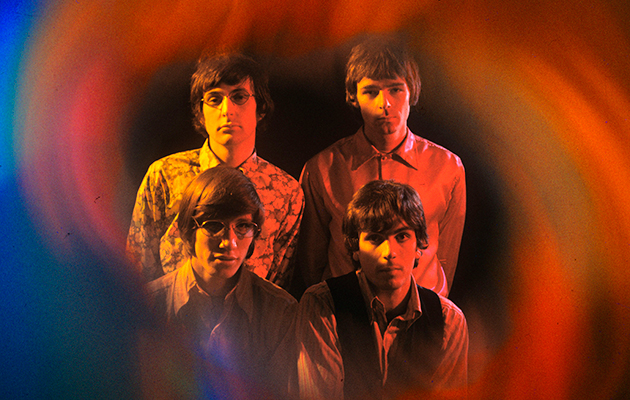The year of psychedelia, 1967, had begun so well for Syd Barrett and the Pink Floyd. Their mix of R’n’B grooves, out-there improvisation and innovative slide projections, accompanying covers such as Bo Diddley’s “I Can Tell” and originals like “Astronomy Domine”, had secured them prestigious gigs on London’s underground scene. On December 23, 1966, they played the opening night of a new club, UFO, while on New Year’s Eve, they joined The Who and The Move for the all-night Psychedelicamania at the Roundhouse in Camden.
At the end of January 1967, the Floyd headed to the four-track Sound Techniques studio in Chelsea with UFO founder Joe Boyd to cut a debut single to shop to labels. Chosen as the A-side, the infectious “Arnold Layne”, with its lyrics about the titular character’s fondness for stealing women’s underwear and his resulting incarceration, took Barrett over a month to finesse.
“I don’t think there was any pressure at the time that we recorded ‘Arnold Layne’,” says Andrew King. “The band felt they could do anything. I’m not saying it was easy – that lyric looks deceptively simple, but it’s very subtle and layered in all sorts of ways. There’s this popular idea that Syd would take some acid, go to bed, get up in the morning and write a masterpiece, but it’s not really like that. Syd worked very, very hard. People just see a drug-crazed genius, but I see a lot of hard work and skill.”
“I think everybody knew what the task was,” remembers Joe Boyd, “which was to make a three-minute single. And so the challenge was to try and evoke the atmosphere that happened over 10 minutes in UFO. And I think we succeeded reasonably well. Creatively, Syd was definitely the leader. They all looked up to him. He wasn’t that talkative in the studio, but when there was a decision to be made, or an opinion to be sought, everybody would turn and look at Syd. Roger was more the spokesman, he was the one who would engage with me, sit beside us at the desk and say, ‘Oh, bring that up a little bit.’ But Syd was definitely the creative leader.”
Signing to EMI on February 28, 1967, they were picked up by Abbey Road producer Norman Smith, who was determined to be the George Martin to their Beatles. “George and Norman didn’t act like they were the bosses, they wanted to use the creativity of the artist,” says engineer and producer Ken Scott. “When Norman had worked with The Beatles, they were coming up to the control room and all that, and Norman got used to that.”
This pact with the establishment had its drawbacks, though, as the group learned when EMI HQ at Manchester Square rejected “Arnold Layne”’s B-side, “Candy And A Current Bun”, for its line “I’m high, don’t try to spoil my fun.” The song’s title had already been changed from the pot-referencing “Let’s Roll Another One”, but still, Barrett and Boyd were forced to return to Sound Techniques.
“A month after we’d mixed the record, we had to go back in and do it again,” says Boyd. “We had to drop Syd in on that verse, erasing the line we had before.”
Recording for the band’s gnomic debut album, The Piper At The Gates Of Dawn, began in earnest, with the group ensconced at Abbey Road’s Studio Three, while The Beatles tracked Sgt Pepper in the larger Studio Two and classical musicians such as Jacqueline du Pré recorded Elgar in Studio One.
“You look back on Abbey Road and that whole culture of doing things properly,” says Nick Mason, “and it’s absolutely amazing. The standards were fabulous. Before a standard session, our bloke would set everything up. We would have to do the drum sound again, because it wasn’t a lock-out system and everything was set up fresh each time. Most of the engineers were very well-trained, so they knew how to get things done quickly. That was one of the joys of the place.”
It was an eccentric place: chief engineer on Piper was Peter Bown, who constantly applied liquid skin to his fingertips because he was worried that the faders were wearing his fingers down; technical staff still wore white lab coats, and a mysterious engineer known as Eddie would appear with grey boxes that produced all manner of effects.
“Piper was recorded on four-track in mono,” remembers Mason. “We would have done drums and bass together at the same time, and a guide guitar and keyboard, then they would be bumped down to one track, to give another three tracks [for overdubs]. And that would be it, because after that you’d be worried about hiss build.
“At Abbey Road, there were three sessions a day: nine to 12, two ’til five and then seven ’til 10. The Beatles had special dispensation to go beyond those times, though. When we made Piper, we renegotiated our contract so that we took a smaller percentage and had unlimited studio time, which probably was silly, as we’d have had more money and worked harder – there’s nothing like knowing you’ve got unlimited studio time to go, ‘Oh, let’s sit around playing cards.’”



